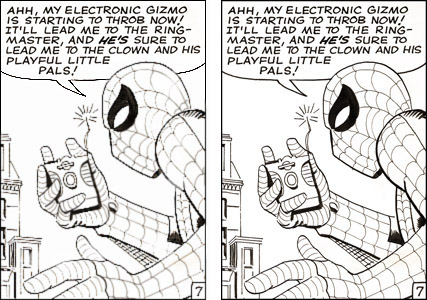My Great Interrogator, Brian Dreger, writes to interrogate me thusly…
I am re-reading the DC Archive editions of the Legion of Superheroes (I find these old stories charming with their simplistic storylines, and I love this eras artwork). But on the inside page with the copyright info, I noticed this credit: "black-and-white reconstruction on selected interior pages by Rick Keene." What does that mean (all the stories printed inside are in color)? And why would they need to be reconstructed? As far as I can tell, these stories are from the late 1950s & early 1960s.
Okay. At some point in our history, the coloring of comic books switched from what were sometimes called "hand-cut" color separations to digital color separations. "Hand-cut seps" were done by hand with people cutting multiple overlays for each page and it was a tedious, labor-intensive and not all-that-good process. The digital kind are done on computers.
Reprinting the latter merely involves using the original digital files again and those are almost always available. Digital files are a lot easier to store than the old film was. They don't rot and it's easy and basically free to make plenty of back-up copies.
Reprinting comics from the earlier era can be way more complicated depending on what source material is available. This would be the case with anything from the seventies or earlier and some comics from the eighties. The absolute best thing would be if you had access to the film or negatives from which the original printing plates were made. That material though is almost always long-destroyed or thrown away…and even if it is around, it's probably decomposed. If you do locate good film, it may be difficult to adapt it for certain modern-day printing techniques.
In the absence of that, you have two choices. You could scan copies of the printed comics in color and have someone do a lot of computer clean-ups and adjustments on the scanned images. This is a form of reconstruction but often, it yields a product that looks a bit muddy and has all or most of the flaws of the cheap, original printing.
Or you could do reconstruction starting with the original black-and-white image that the artist(s) drew. This work would have to be recolored and you would then have the option to copy the original coloring or to do new coloring. Since the work would now be printed with better printing on better paper, and since coloring techniques have improved since then, you would probably opt to have someone do new coloring that didn't slavishly follow the original coloring.
But to reconstruct, you need that good black-and-white image of the page. Once in a while, the original art is available and that can be scanned but usually those pages are hard if not impossible to find.
Publishers usually (not always) kept good black-and-white photostats of their published material in case they wanted to reprint it later or some company overseas wanted to buy the rights to reprint that material in their country. Those stats would enable you to begin reconstructing the work but sometimes, they just plain don't have any. They were lost. They were thrown away. In a few cases, a publisher somewhere — let's say in the Republic of Botswana — purchased reprint rights so someone at the company shipped a set of stats to Botswana not realizing it was the company's last set.
Also, comic book publishers have sometimes been some of the cheapest people on this planet and they didn't bother to make good stats. That is an example of a widespread problem that many businesses in this country face. The folks running the company at one point didn't want to spend the dough to preserve certain assets which could now yield revenue.
You're probably aware that certain movies or TV shows cannot now be shown or monetized via home video because no decent copies of them exist. The same thing happened with some comic books. Someone didn't want to spend money on preservation. If they made stats at all, they made them on really cheap paper and the images have faded or the paper has turned brown and moldy.

So what they do in this case is to locate a printed copy of the comic, scan it and then have someone filter the color out of the page leaving the black-and-white line art. But the process that takes out the darker colors will probably take some of the black lines with it so the pages may need serious retouching. This is what they mean when they say "restoration." It's doing a digital re-inking of the pages to repair damaged linework.
So that's what they're talking about when they mention "reconstruction." Someone had to fix up bad source material so that the comic book could be reprinted. Sometimes, minor surgery is necessary. Sometimes, major. Sometimes, it's done so well that it's hard to detect. At other times, it's obvious and collectors have been known to complain. My own observation is that it's getting better and better…with occasional exceptions.
